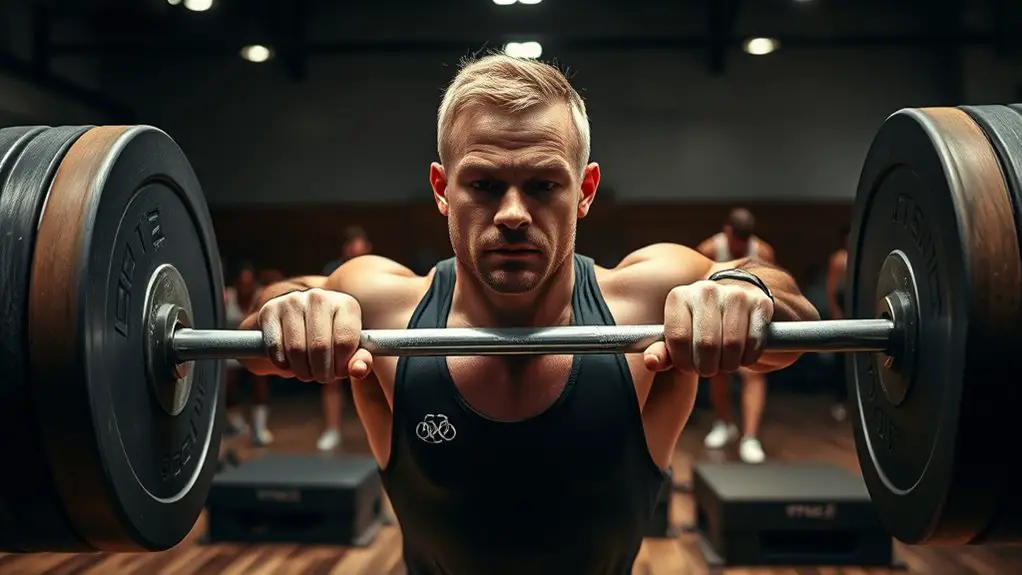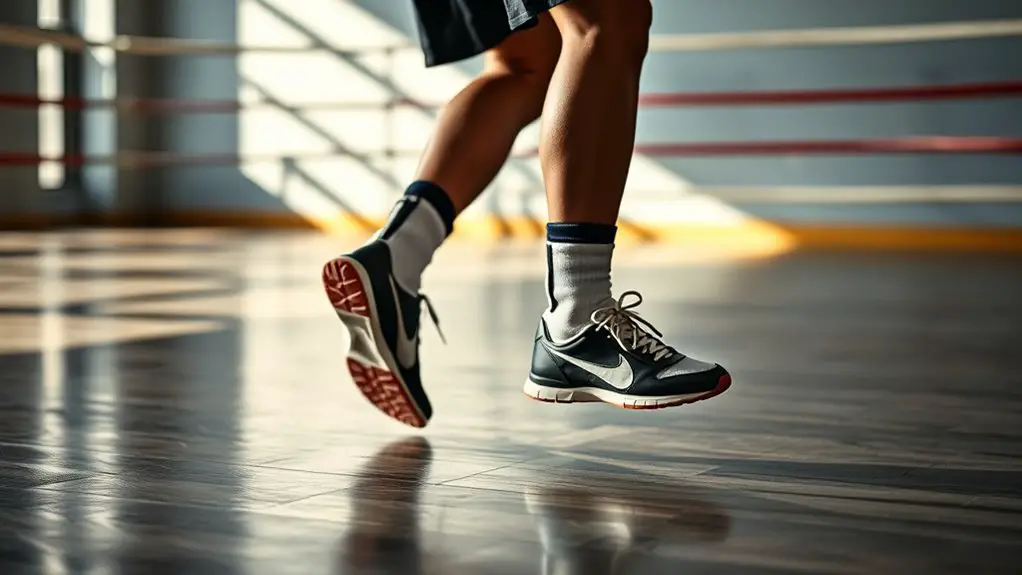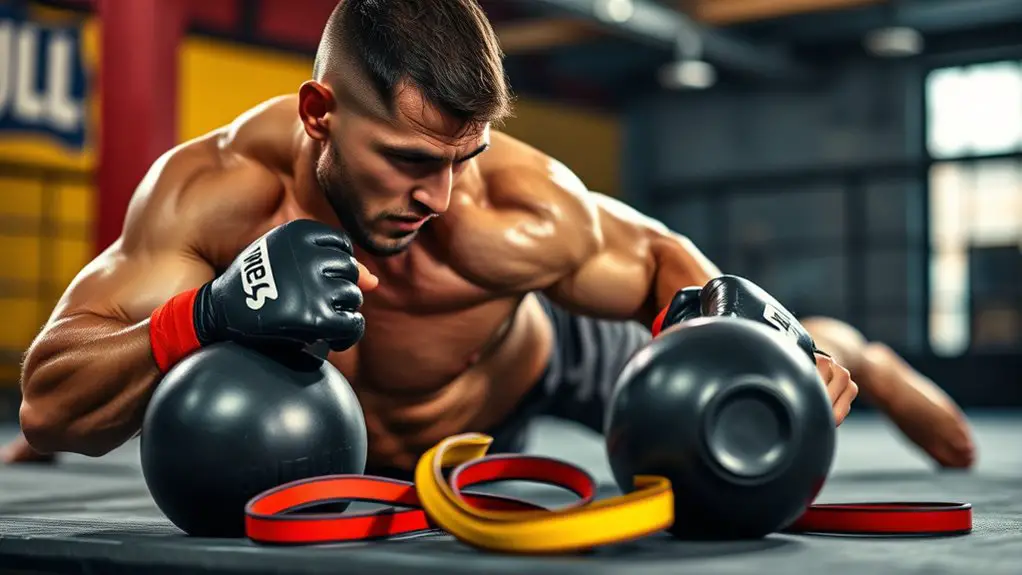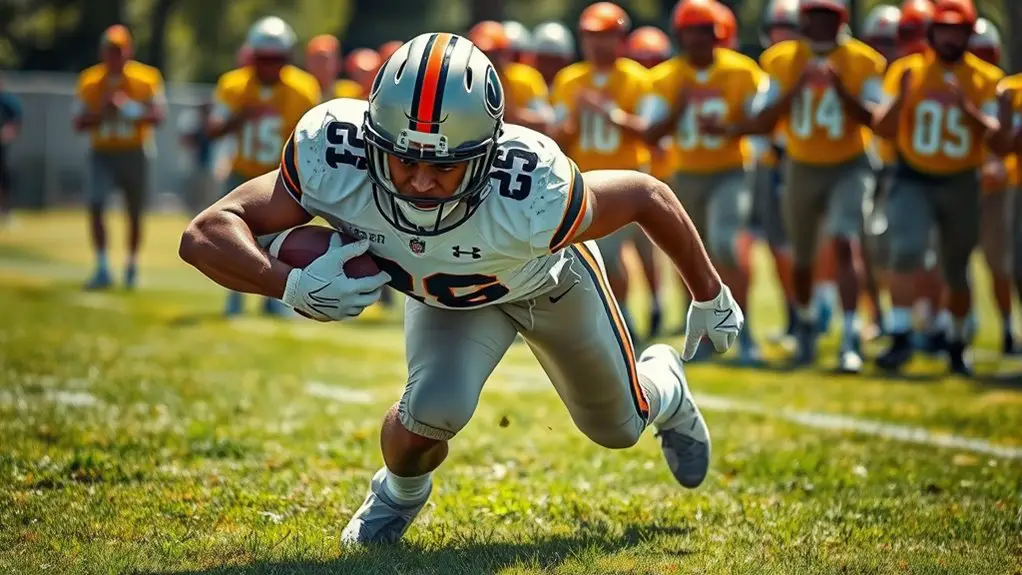To boost your athletic performance, incorporate Olympic lifting variations like the power clean, hang clean, and snatch into your routine. These movements develop explosive strength and enhance coordination, essential for sports. Don't forget the clean and jerk for power and technique, along with overhead and front squats to improve stability. The push press and split jerk also build upper body strength. Curious about how these lifts can transform your training? There's more to explore!
Power Clean
The Power Clean is one of the most effective Olympic lifting variations, and it's a favorite among athletes for good reason. This dynamic movement not only enhances your explosive strength but also develops coordination and agility, giving you the freedom to move more efficiently in your sport. To master the power clean technique, focus on your grip, body position, and the speed of your pull. You'll want to drive through your legs and keep the bar close to your body, allowing for a smooth shift into the catch position.
The power clean benefits extend beyond just athletic performance; it strengthens your entire posterior chain, helping to prevent injuries and improve overall stability. By incorporating this lift into your routine, you can access your potential and elevate your fitness game. Embrace the power clean, and watch how it transforms your strength and athleticism! Additionally, mastering the power clean will help develop your fast-twitch muscle fibers, which are vital for explosiveness in various sports.
Hang Clean
The hang clean is a powerful lift that offers numerous benefits for both strength and explosiveness. To get the most out of this variation, it's essential to master the proper technique. Let's break down how to execute the hang clean effectively and explore its advantages. Incorporating the hang clean into your routine can significantly enhance overall strength and athletic performance, making it a valuable addition to functional strength training.
Benefits of Hang Clean
Hang cleans offer numerous benefits for athletes and fitness enthusiasts alike. They're a fantastic way to build explosive power, which is essential for sports performance. By incorporating hang clean variations into your training, you can target multiple muscle groups, enhancing strength and coordination. This exercise also improves your grip strength, helping you in various lifting scenarios. Additionally, hang cleans promote better posture and core stability, allowing you to move more freely in your activities. The dynamic nature of this lift keeps workouts engaging, preventing monotony. With the hang clean benefits, you'll find yourself not only stronger but also more athletic and agile. So, why not give it a shot and elevate your training routine?
Proper Technique Breakdown
Explosive power and strength gains from hang cleans are only achievable with proper technique. Start by positioning the barbell at mid-thigh level, ensuring your grip is secure. As you initiate the lift, engage your core and drive through your heels, using your legs to propel the weight upward. During the pull, keep the bar close to your body to enhance movement efficiency. As the bar reaches its peak, quickly drop under it, catching it in a strong front rack position. Technique analysis reveals that maintaining a neutral spine is critical to avoid injury and maximize lift potential. By focusing on these elements, you'll not only improve your hang clean but also release your athletic freedom.
Snatch
When it comes to the snatch, mastering your technique and form is essential for success. This explosive lift not only requires strength and power but also demands a good amount of mobility and flexibility. Engaging multiple muscle groups during the snatch can significantly enhance your overall power output.
Technique and Form
Mastering the snatch requires meticulous attention to technique and form, as even small mistakes can lead to significant setbacks in performance and safety. You need to focus on your grip, stance, and bar path to maximize force production. Begin with a strong setup: feet shoulder-width apart, bar close to your shins, and back tight. As you lift, generate explosive strength by driving through your legs and extending your hips. Keep the bar close; it should travel in a straight line. Your elbows must rotate quickly under the bar during the catch phase to stabilize the weight overhead. Regularly video your lifts to spot errors and make necessary adjustments. Prioritize technique over weight—freedom in lifting comes from mastery of form.
Strength and Power
To build strength and power for the snatch, it is crucial to focus on developing your overall explosiveness and speed. Incorporate exercises like power cleans and jump squats to enhance your explosive strength. These movements not only target your legs but also engage your core, promoting stability and power development. Don't forget to include variations like the hang snatch, which helps refine your technique while pushing your limits. Training with heavier weights at lower volumes can also boost your strength, setting a solid foundation for the snatch. Remember, it's about harnessing that explosive energy and translating it into your lifts. Embrace the challenge, and you'll discover newfound freedom in your snatch performance, elevating your athleticism to new heights.
Mobility and Flexibility
While you focus on building strength and power for the snatch, don't overlook the importance of mobility and flexibility. They're essential for achieving that perfect form and preventing injuries. Incorporate dynamic stretching into your warm-up routine to enhance your range of motion. Movements like leg swings and arm circles can really loosen you up.
Additionally, integrating mobility drills like deep squats and hip openers into your training can improve your overhead position. These exercises help you feel free and fluid, making it easier to catch the bar in the proper position. Remember, a well-prepared body allows you to lift with confidence and grace. So, take the time to work on your mobility and flexibility; it'll pay off when you're under the bar.
Clean and Jerk
The Clean and Jerk is one of the most dynamic and powerful lifts in Olympic weightlifting, combining strength, speed, and technique in a single movement. To master this lift, you'll want to focus on clean jerk strategies and clean jerk progression. Here's a quick guide to help you navigate your training:
| Phase | Key Focus |
|---|---|
| First Pull | Drive through your legs |
| Second Pull | Extend explosively |
| Catch Position | Drop under the bar quickly |
| Jerk Setup | Create a solid base |
| Overhead Position | Lockout with active shoulders |
Proper technique enhances lifting efficiency and reduces injury risk, making it crucial to focus on body alignment during your training.
Overhead Squat
After mastering the Clean and Jerk, adding the Overhead Squat to your routine can further enhance your stability and strength in the overhead position. This movement challenges your overhead stability while promoting flexibility and balance. When you lower into the squat, you're not just going up and down; you're performing a depth assessment of your mobility and strength. It allows you to identify limitations in your range of motion, giving you insights to work on. Additionally, prioritizing mobility training can help you maintain joint health and improve body resilience, ultimately leading to better performance.
To perform the Overhead Squat effectively, start with a wide grip on the barbell, keeping it locked overhead. Your feet should be shoulder-width apart, and as you descend, focus on maintaining a strong core and upright torso. This exercise not only builds strength but also empowers you, giving you the freedom to explore new limits in your performance. Embrace the challenge, and watch your overall lifting game improve.
Front Squat
Front Squats are a powerful addition to your Olympic lifting routine, emphasizing strength and control in the anterior chain. By incorporating front squat variations, you can target your quads, core, and upper back more effectively than traditional squats. This variation's upright position allows you to maintain better form, reducing the risk of injury while improving your overall lifting performance.
One of the key front squat benefits is how it translates directly to other lifts, enhancing your stability and power. You'll find that mastering the front squat not only builds strength but also boosts your confidence under the barbell. Plus, it's a fantastic way to develop mobility and flexibility in your hips and ankles. Additionally, a strong core is essential for enhancing stability during these movements, allowing for efficient force transfer and better overall performance.
Push Press
One of the best ways to build explosive strength in your upper body is through the push press. This dynamic movement not only enhances your shoulder stability but also engages your core, making it a fantastic addition to your training routine. The push press benefits you by improving your overall power output, which can translate to better performance in various sports and activities. Additionally, incorporating adequate protein intake post-workout can significantly enhance your muscle recovery and growth.
You can also explore push press variations to keep your workouts fresh and challenging. For instance, try a seated push press to isolate your shoulders or incorporate a pause at the bottom for added stability work. You might even consider using different grips or stances to further target your muscles.
Split Jerk
Although it may seem intimidating at first, the split jerk is an incredibly effective Olympic lifting variation that can greatly enhance your overall athletic performance. Mastering the split jerk techniques allows you to generate explosive power and improve your coordination, vital for many sports.
To execute the split jerk, you'll need to dip and drive through your legs, swiftly shifting into a split stance as you lock the bar overhead. This dynamic movement not only builds upper body strength but also engages your core and legs, providing a full-body workout.
The split jerk benefits extend beyond strength; it can enhance your speed and agility, essential for athletes seeking to excel in their respective fields. Additionally, the split jerk utilizes the stretch-shortening cycle, which is crucial for maximizing explosive movements. Embracing this lift can give you the freedom to perform better and push your limits. So, don't shy away—dive into the split jerk and experience the transformation it brings to your athletic journey.
Snatch Grip Deadlift
The snatch grip deadlift is a powerful variation that can notably improve your strength and technique for Olympic lifting. With a wider grip, this deadlift not only challenges your muscles but also enhances your lifting mechanics. Here are some deadlift benefits you'll enjoy:
The snatch grip deadlift enhances strength and technique, challenging your muscles and improving lifting mechanics.
- Increased Back Strength: The snatch grip forces you to engage your upper back, helping to build a stronger posture for lifts.
- Enhanced Hip Mobility: The wide grip encourages better hip positioning, essential for executing the snatch.
- Improved Grip Strength: Holding the bar with a snatch grip greatly boosts your grip strength, which is vital for all lifts. Additionally, developing grip strength improves stability and coordination, contributing to overall performance.
Frequently Asked Questions
How Can I Prevent Injuries While Performing Olympic Lifts?
To prevent injuries while performing Olympic lifts, focus on injury prevention through proper technique. Make sure you're using the right form for each lift, as this helps avoid unnecessary strain. Start with lighter weights to master the movements before progressing. Don't forget to warm up adequately and incorporate mobility exercises to enhance your range of motion. Listening to your body's signals is essential; if something feels off, it's okay to take a step back.
What Equipment Do I Need for Olympic Lifting Training?
Did you know that nearly 80% of Olympic lifters swear by specialized equipment? To get started with Olympic lifting, you'll need a good quality barbell—consider both standard and Olympic barbell types. Weightlifting shoes are essential too; they provide stability and help maintain proper form. With the right gear, you can explore your potential and enjoy the freedom of lifting. So gear up, and let your training journey begin with confidence!
How Often Should I Train Olympic Lifting Variations?
How often you train Olympic lifting variations really depends on your individual goals and recovery protocols. Generally, aiming for 2 to 4 times a week can be effective, but it's essential to listen to your body. If you're feeling fatigued, don't hesitate to adjust your training frequency. Balancing intense sessions with proper recovery will help you enjoy the freedom of lifting while minimizing the risk of injury. Find what feels best for you!
Are There Specific Warm-Up Exercises for Olympic Lifts?
Yes, there are specific warm-up exercises that can enhance your Olympic lifting. Start with dynamic stretches to get your muscles activated and increase your heart rate. Incorporate mobility drills targeting your hips, shoulders, and ankles to improve your range of motion. Movements like leg swings and arm circles can be particularly effective. This warm-up routine not only prepares your body but also allows you to lift with more freedom and confidence.
Can Olympic Lifting Improve My Overall Athletic Performance?
Absolutely, Olympic lifting can greatly improve your overall athletic performance. It focuses on power development, which translates to explosive strength in various sports. By incorporating these lifts into your routine, you'll enhance your agility, coordination, and speed. Plus, the dynamic nature of Olympic lifts builds resilience and mental toughness, giving you more freedom in your movement and performance. So, if you're looking to elevate your game, it's definitely worth considering!




